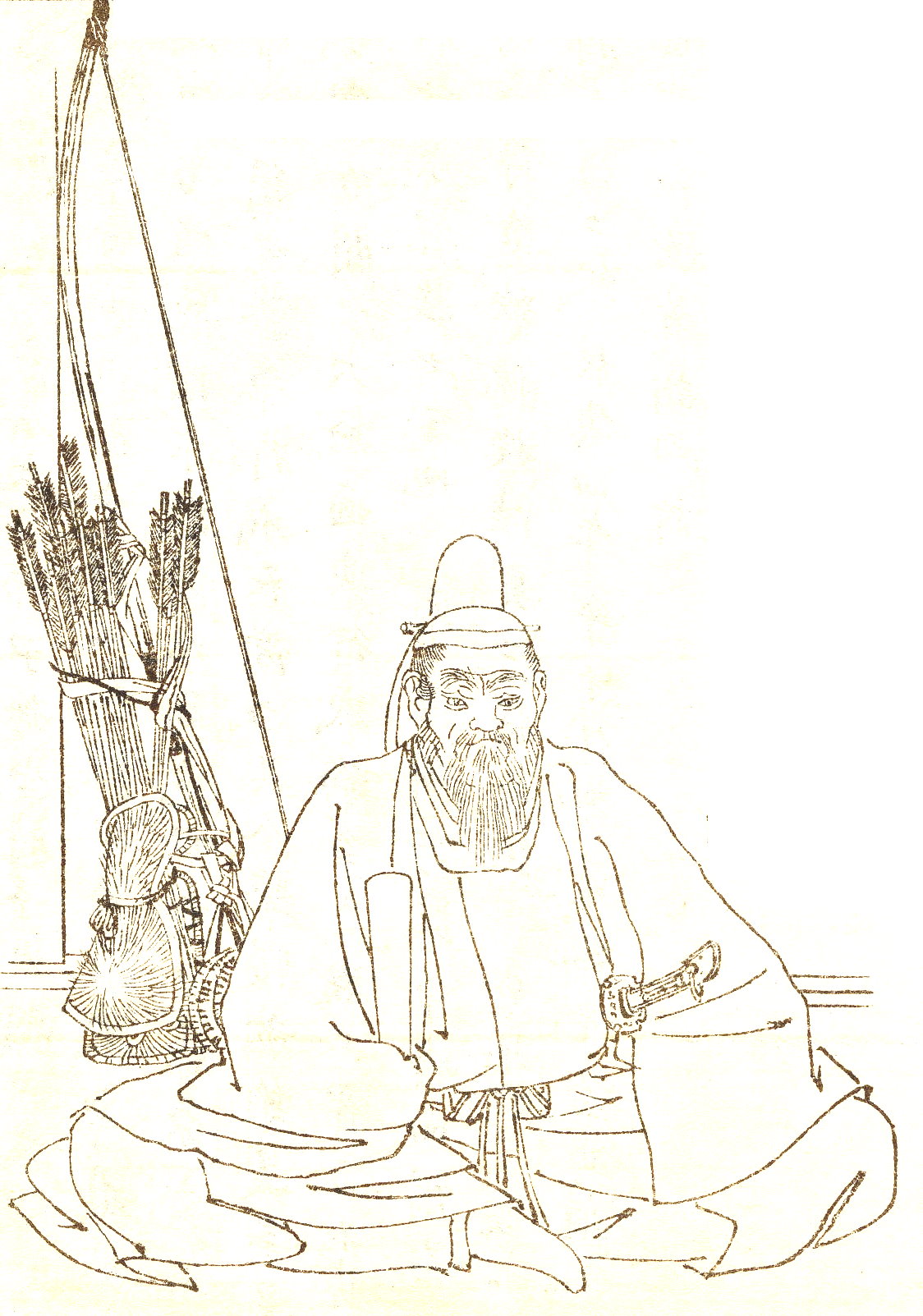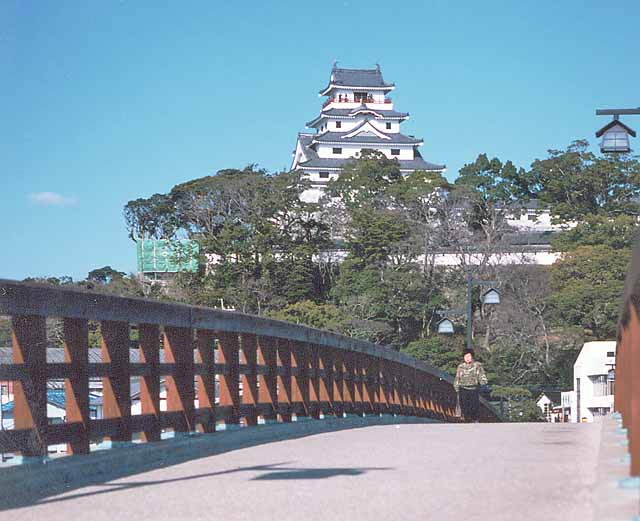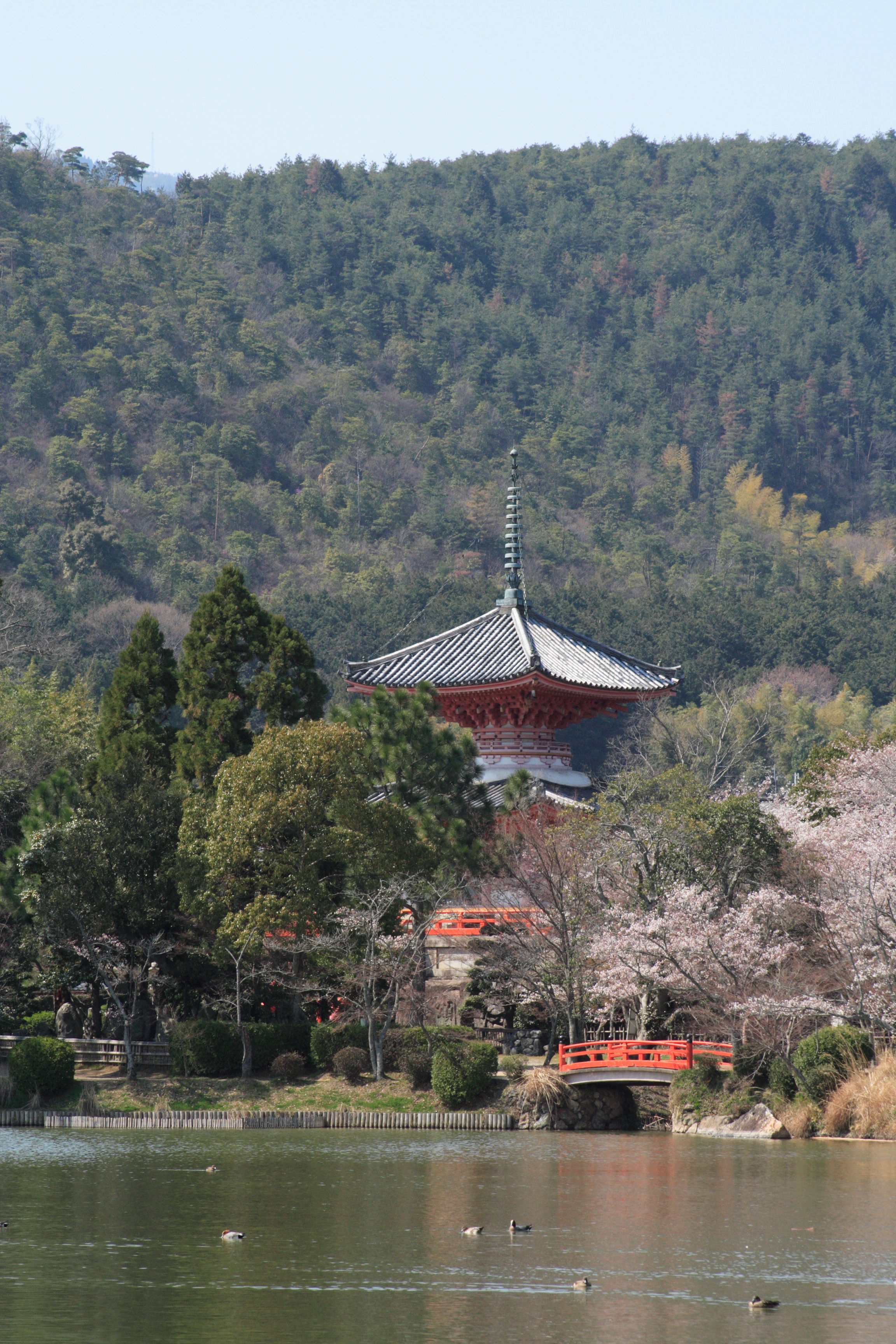|
Yorimitsu Minamoto
, also known as Minamoto no Raikō, served the regents of the Fujiwara clan along with his brother Yorinobu, taking the violent measures the Fujiwara were themselves unable to take. He is one of the earliest Minamoto of historical note for his military exploits, and is known for quelling the bandits of Ōeyama. His loyal service earned him the governorships of Izu Province, Kozuke and a number of others in turn, as well as a number of other high government positions. Yorimitsu served as commander of a regiment of the Imperial Guard, and as a secretary in the Ministry of War. When his father Minamoto no Mitsunaka died, he inherited Settsu Province. Yorimitsu is usually accompanied by his four legendary retainers, known as the Shitennō (The Four Heavenly Kings). They were Watanabe no Tsuna, Sakata no Kintoki, Urabe no Suetake, and Usui Sadamitsu. Legends Yorimitsu featured in a number of legends and tales, including the legend of Kintarō (Golden Boy a.k.a. Sakata no Kintoki ... [...More Info...] [...Related Items...] OR: [Wikipedia] [Google] [Baidu] |
Minamoto No Mitsunaka
was a Japanese samurai and court official of the Heian period. He served as '' Chinjufu-shōgun'' and acting governor of Settsu Province''.'' His association with the Fujiwara clan made him one of the wealthiest and most powerful courtiers of his day. He was also the predecessor of Takeda ryu. Biography He was born on April 29, 912, as Myoomaru (明王丸), the son of Minamoto no Tsunemoto. He belonged to the Seiwa Genji branch of the Minamoto clan, which traced its ancestry to Emperor Seiwa. He loyally (if not selflessly) served several successive Fujiwara regents ('' sessho and kampaku'') beginning with Fujiwara no Morotada. There is debate among scholars as to his involvement in the Anna Plot of 969 (named for the era it took place in). All agree that Mitsunaka alleged that Minamoto no Takaakira was plotting against the Emperor. However, whilst some believe that there was a genuine threat to the Emperor, and that it was Mitsunaka's warning that prevented the plot from succ ... [...More Info...] [...Related Items...] OR: [Wikipedia] [Google] [Baidu] |
Tachi
A is a type of traditionally made Japanese sword (''nihonto'') worn by the samurai class of feudal Japan. ''Tachi'' and ''katana'' generally differ in length, degree of curvature, and how they were worn when sheathed, the latter depending on the location of the ''mei'' (銘), or signature, on the tang. The ''tachi'' style of swords preceded the development of the ''katana'', which was not mentioned by name until near the end of the twelfth century. ''Tachi'' were the mainstream Japanese swords of the Kotō period between 900 and 1596. Even after the Muromachi period (1336–1573), when ''katana'' became the mainstream, ''tachi'' were often worn by high-ranking samurai. History The production of swords in Japan is divided into specific time periods: * ''Jōkotō'' (ancient swords, until around 900) * ''Kotō'' (old swords from around 900–1596) * ''Shintō'' (new swords 1596–1780) * ''Shinshintō'' (new new swords 1781–1876) * ''Gendaitō'' (modern or contemporary sw ... [...More Info...] [...Related Items...] OR: [Wikipedia] [Google] [Baidu] |
Oni (folklore)
An is a kind of ''yōkai'', demon, orc, ogre, or troll in Japanese folklore. Oni are mostly known for their fierce and evil nature manifested in their propensity for murder and cannibalism. Notwithstanding their evil reputation, oni possess intriguingly complex aspects that cannot be brushed away simply as evil. They are typically portrayed as hulking figures with one or more horns growing out of their heads."Oni." ''Handbook of Japanese Mythology'', by Michael Ashkenazi, ABC-CLIO, 2003, pp. 230–233. Stereotypically, they are conceived of as red, blue, black, yellow, or white-colored, wearing loincloths of tiger pelt, and carrying iron kanabō clubs. They are creatures which instill fear and feelings of danger due to their grotesque outward appearance, their wild and sometimes strange behavior and their powers. They are popular characters in Japanese art, literature, and theater and appear as stock villains in the well-known fairytales of ''Momotarō'' (''Peach Boy''), ''I ... [...More Info...] [...Related Items...] OR: [Wikipedia] [Google] [Baidu] |
Helmet
A helmet is a form of protective gear worn to protect the head. More specifically, a helmet complements the skull in protecting the human brain. Ceremonial or symbolic helmets (e.g., a policeman's helmet in the United Kingdom) without protective function are sometimes worn. Soldiers wear combat helmets, often made from Kevlar or other lightweight synthetic fibers. The word ''helmet'' is derived from ''helm'', an Old English word for a protective head covering. Helmets are used for recreational activities and sports (e.g., jockeys in horse racing, American football, ice hockey, cricket, baseball, camogie, hurling and rock climbing); dangerous work activities such as construction, mining, riot police, military aviation, and in transportation (e.g. motorcycle helmets and bicycle helmets). Since the 1990s, most helmets are made from resin or plastic, which may be reinforced with fibers such as aramids. Designs Some British gamekeepers during the 18th and 19th centuries wore he ... [...More Info...] [...Related Items...] OR: [Wikipedia] [Google] [Baidu] |
Mikoshi
A is a sacred religious palanquin (also translated as portable Shinto shrine). Shinto followers believe that it serves as the vehicle to transport a deity in Japan while moving between main shrine and temporary shrine during a festival or when moving to a new shrine. Often, the ''mikoshi'' resembles a miniature building, with pillars, walls, a roof, a veranda and a railing. Often the Japanese honorific prefix is added, making . Traditional rituals of East Asia Shapes Typical shapes are rectangles, hexagons, and octagons. The body, which stands on two or four poles (for carrying), is usually lavishly decorated, and the roof might hold a carving of a phoenix. Festival and flow During a ''matsuri'' (Japanese festival) involving a ''mikoshi'', people bear the ''mikoshi'' on their shoulders by means of two, four (or sometimes, rarely, six) poles. They bring the ''mikoshi'' from the shrine, carry it around the neighborhoods that worship at the shrine, and in many cases l ... [...More Info...] [...Related Items...] OR: [Wikipedia] [Google] [Baidu] |
Saga Prefecture
is a prefecture of Japan located on the island of Kyushu. Saga Prefecture has a population of 809,248 (1 August 2020) and has a geographic area of 2,440 km2 (942 sq mi). Saga Prefecture borders Fukuoka Prefecture to the northeast and Nagasaki Prefecture to the southwest. Saga is the capital and largest city of Saga Prefecture, with other major cities including Karatsu, Tosu, and Imari. Saga Prefecture is located in the northwest of Kyūshū covering an isthmus-like area extending between the Sea of Japan and the Ariake Sea. Saga Prefecture's western region is known for the production of ceramics and porcelain, particularly in the towns of Karatsu, Imari, and Arita. History In ancient times, the area composed by Nagasaki Prefecture and Saga Prefecture was called Hizen Province. The current name dates from the Meiji Restoration. Rice farming culture has prospered here since ancient times, and vestiges can be seen at the ruins of Nabatake in Karatsu and the Yoshinogari sit ... [...More Info...] [...Related Items...] OR: [Wikipedia] [Google] [Baidu] |
Karatsu, Saga
is a city located in Saga Prefecture on the island of Kyushu, Japan. Its name, formed from the Japanese word roots 唐 ''kara'' (China, or continental East Asia in general), and 津 ''tsu'' (port), signifies its historical importance as an ancient trading port between Japan with China and Korea. The central area of Karatsu, which does not include the former cities and villages of Higashimatsuura District, has a population of 78,386. As of January 1, 2020, the city had an estimated population of 117,663 and a population density of 241 persons per km2. The total area is 487.59 km2. On January 1, 2005, the towns of Chinzei, Hamatama, Hizen, Kyūragi, Ōchi, Yobuko and the village of Kitahata (all from Higashimatsuura District) were merged into Karatsu. On January 1, 2006, the village of Nanayama (from Higashimatsuura District) was merged into Karatsu. Geography Due to its proximity to mainland Asia, Karatsu has long been known as a stopover to Korea and China. ... [...More Info...] [...Related Items...] OR: [Wikipedia] [Google] [Baidu] |
Matsuri
Japanese festivals are traditional festive occasions often celebrated with dance and music in Japan. Many festivals have their roots in Traditional Chinese holidays, traditional Chinese festivals, but have undergone extensive changes over time to have little resemblance to their original form, despite sharing the same name and date. There are also various local festivals (e.g. Tobata Gion) that are mostly unknown outside a given prefecture. Unlike most people in East Asia, Japanese people generally do not celebrate the Lunar New Year, its observance having been supplanted by the Western New Year's Day on January 1 in the late 19th century (see Japanese New Year); however, many continue to observe several of its cultural practices. Many Chinese residents in Japan, as well as more traditional shrines and temples, still celebrate the Lunar New Year in parallel with the Western New Year. In Yokohama Chinatown, Japan's biggest Chinatown, tourists from all over Japan come to enjoy the ... [...More Info...] [...Related Items...] OR: [Wikipedia] [Google] [Baidu] |
Karatsu Kunchi
Karatsu Kunchi (唐津くんち; the suffix "kunchi" simply meaning festival) is a Japanese festival that takes place annually in the city of Karatsu, Saga Prefecture, on Japan's island of Kyūshū. About The festival, which begins on the evening of November 2 and concludes on 4th, features daily parades of fourteen '' hikiyama'', massive floats in the form of samurai helmets, sea bream, dragons, and other fantastical creatures, all constructed from wood, lacquer, and other materials. It is the major event of the Karatsu calendar, regularly drawing crowds of anywhere between 150,000 and 500,000 people from the surrounding area over the course of the three-day holiday. Each float — which stand between five and six meters, and which weigh anywhere from two to five tons — is drawn through the streets of the city by teams of bearers selected from families living in the fourteen traditional neighborhoods of Karatsu, to the chant of "En-ya! En-ya! En-ya!"(or"Yoi-sa! Yoi-sa! Yoi ... [...More Info...] [...Related Items...] OR: [Wikipedia] [Google] [Baidu] |
Hakone Shrine
The is a Japanese Shinto shrine on the shores of Lake Ashi in the town of Hakone in the Ashigarashimo District of Kanagawa Prefecture.Kotodamaya.com"Hakone Jinja" retrieved 2013-1-27. It is also known as the . Nussbaum, Louis-Frédéric. (2005)"Hakone Gongen-jinja"in ''Japan Encyclopedia'', p. 279. Enshrined ''kami'' The primary ''kami'' of Hakone Shrine are * * * They are known collectively as the . History According to shrine tradition, ''Hakone-jinja'' was founded in 757 during the reign of Emperor Kōshō. The original shrine was at the summit of the Komagatake peak of Mount Hakone. The shrine was relocated to the shores of Lake Ashi; its current form dates to 1667. Credit for establishment is also given to Priest Mangan, for pacifying the nine-headed dragon that lived at the bottom of Lake Ashi. According to the ''Azuma Kagami'', Minamoto no Yoritomo sought guidance and shelter from the kami at Hakone after his defeat in Battle of Ishibashiyama during the Genp ... [...More Info...] [...Related Items...] OR: [Wikipedia] [Google] [Baidu] |
Daikaku-ji
is a Shingon Buddhist temple in Ukyō-ku, a western ward in the city of Kyoto, Japan. The site was originally a residence of Emperor Saga (785–842 CE), and later various emperors conducted their cloistered rule from here. The ''Saga Go-ryū'' school of ikebana has its headquarters in the temple. The artificial lake of the temple, Ōsawa Pond, is one of the oldest Japanese garden ponds to survive from the Heian period. History The origins of the temple dates back to the Heian period in the year 814 CE, when Emperor Saga had a palace, known as the ''Saga-in'', constructed on the site. The palace later became his seat of retirement, known as ''Saga Rikyu'' imperial villa. According to tradition, when Japan suffered a serious epidemic, the Buddhist monk Kobo Daishi, the founder of Shingon Buddhism, suggested that the Emperor Saga personally copy an important Buddhist religious document called the Heart Sutra (''Hannya Shingyō''). The emperor made a handwritten copy, and ... [...More Info...] [...Related Items...] OR: [Wikipedia] [Google] [Baidu] |
Yomiuri Shimbun
The (lit. ''Reading-selling Newspaper'' or ''Selling by Reading Newspaper'') is a Japanese newspaper published in Tokyo, Osaka, Fukuoka, and other major Japanese cities. It is one of the five major newspapers in Japan; the other four are the ''Asahi Shimbun'', the ''Chunichi Shimbun (Tokyo Shimbun)'' the ''Mainichi Shimbun'', and the '' Nihon Keizai Shimbun''. It is headquartered in Otemachi, Chiyoda, Tokyo.' It is a newspaper that represents Tokyo and generally has a conservative orientation. It is one of Japan's leading newspapers, along with the Osaka-based liberal (Third way) Asahi Shimbun and the Nagoya-based Social democratic Chunichi Shimbun. It is published by regional bureaus, all of them subsidiaries of The Yomiuri Shimbun Holdings, Japan's largest media conglomerate by revenue and the second largest media conglomerate by size behind Sony,The Yomiuri Shimbun Holdings is the largest media conglomerate by revenue in Japan, while Sony is Japan's largest media con ... [...More Info...] [...Related Items...] OR: [Wikipedia] [Google] [Baidu] |










